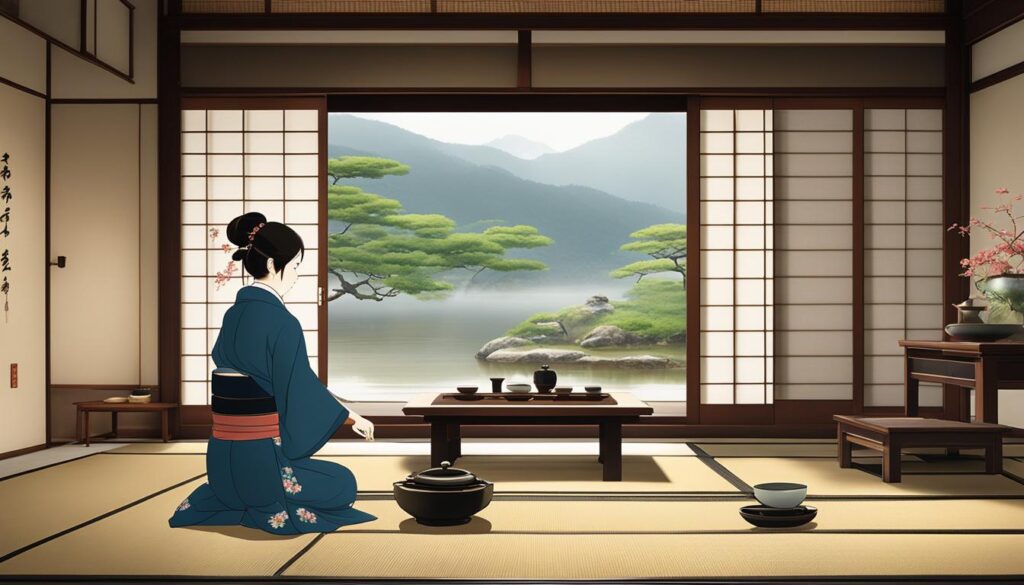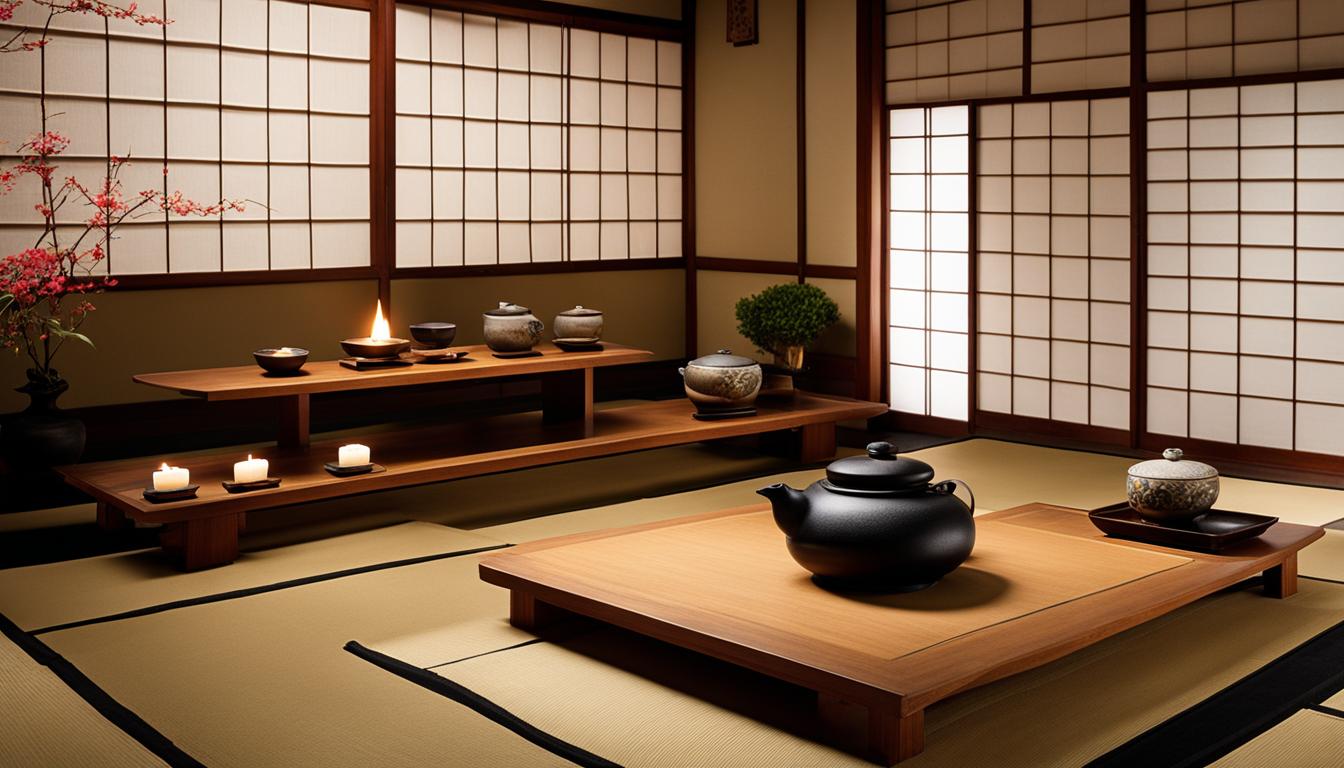Welcome to our exploration of the fascinating world of the Japanese tea ceremony! Known as Sado or the Way of Tea, this ancient practice is deeply rooted in Japanese culture, embodying harmony, respect, and peace. Let us delve into the rituals, movements, and seasonality of this unique ceremonial tradition.
In the 16th century, the Japanese tea ceremony originated as a way for the elite members of society to socialize and connect. It goes beyond mere tea drinking; it is a transformative experience that allows participants to appreciate the beauty and tranquility woven into every step of the ceremony.
The ceremony involves precise movements and the use of specialized utensils, each serving a purpose in creating an atmosphere of mindfulness. From the selection of the right matcha powder to the observance of specific guest etiquette, every detail contributes to the depth and richness of the experience.
Key Takeaways:
- Japanese Tea Ceremony rituals explained
- Japanese Tea Ceremony ceremonial steps
- Sado Japanese Tea Ceremony
- Japanese Tea Ceremony movements
- Japanese Tea Ceremony seasonality
- Japanese Tea Ceremony guest etiquette
Introducing Marky’s Tea Collection and the Art of Japanese Tea Ceremony
Welcome to Marky’s Tea Collection, where we celebrate the art and ritual of the Japanese tea ceremony. Our collection is curated by Marky, a passionate tea lover who has selected the finest teas from Japan and beyond. We believe that the tea ceremony is more than just a beverage; it is a holistic experience that encompasses preparation, presentation, and consumption.

The Japanese tea ceremony is deeply rooted in tradition and requires patience, skill, and a deep appreciation for beauty. It is an art form that promotes mindfulness and invites us to embrace harmony and tranquility. At Marky’s Tea Collection, we offer a range of teas and tea accessories that are essential for practicing the Omotesenke and Urasenke tea ceremony rituals.
Whether you are a seasoned tea ceremony practitioner or a beginner looking to delve into this rich cultural practice, our collection has something for everyone. Immerse yourself in the sequence and formalities of the Japanese tea ceremony with our meticulously selected teas and authentic tea utensils. Experience the grace and elegance of the tea ceremony in the comfort of your own home.
Embrace the Ritual
The Japanese tea ceremony follows a sequence that is steeped in tradition and formalities. It is a four-step process that involves preparation, presentation, enjoyment, and conclusion. Each step is carefully orchestrated to create a harmonious and immersive experience.
- Preparation: The host prepares the tea with precision and attention to detail, ensuring every element of the ceremony is executed flawlessly.
- Presentation: The host presents the tea to the guests, bowing as a sign of respect. Guests admire the beauty of the tea utensils and engage in conversation while savoring the tea.
- Enjoyment: The guests thoroughly enjoy the tea, appreciating its flavor and aroma while engaging in mindful conversation.
- Conclusion: The host cleans and prepares the utensils, signaling the end of the tea ceremony. A sense of harmony and gratitude permeates the atmosphere.
At Marky’s Tea Collection, we provide the tools and knowledge needed to fully embrace the ritual of the Japanese tea ceremony. Elevate your tea-drinking experience and cultivate a deeper connection with the art of tea.
The Preparation of Matcha – Exploring the Varieties of Matcha Powders
Matcha, a powdered green tea, is a key component of the Japanese tea ceremony. The process of preparing matcha involves carefully selecting the right type of matcha powder, as each variety offers a unique taste and texture. Several factors, such as the location and conditions in which the tea leaves are grown, contribute to the flavor profile and quality of matcha powder.
There are two main types of matcha powders commonly used: ceremonial grade matcha and culinary matcha. Ceremonial grade matcha is the most prized and is reserved for formal tea ceremonies. It possesses a delicate, grassy flavor with subtle mineral undertones. On the other hand, culinary matcha is more robust and earthy in taste, making it suitable for cooking and everyday consumption.
| Matcha Type | Flavor Profile | Suitability |
|---|---|---|
| Ceremonial Grade Matcha | Delicate, grassy, with subtle mineral undertones | Formal tea ceremonies |
| Culinary Matcha | Robust and earthy | Cooking and everyday consumption |
When exploring the varieties of matcha powders, it’s essential to consider their specific characteristics and intended use. Ceremonial grade matcha provides a refined and elegant experience, best suited for formal occasions. Its smooth, velvety texture and rich flavor create a harmonious blend with hot water, resulting in a frothy and vibrant cup of tea. Culinary matcha, on the other hand, offers versatility and can be used in a wide range of culinary applications, including adding a unique twist to baked goods, smoothies, or even savory dishes.
By understanding the nuances of matcha powders and their different uses, one can truly appreciate the depth and richness of the Japanese tea ceremony. Whether sipping on ceremonial grade matcha or incorporating culinary matcha into everyday recipes, the experience of matcha preparation brings a sense of mindfulness and an appreciation for the seasonality and movements of the tea ceremony.
Understanding the Four Steps of Japanese Tea Ceremony – A Guide to Enjoying Every Sip
The Japanese tea ceremony is a beautiful and intricate practice that encompasses four essential steps. Each step is carefully designed to create a harmonious and mindful experience for both the host and guests. By understanding these steps and embracing the etiquette and ritualistic movements involved, one can fully immerse themselves in the Japanese tea ceremony and truly enjoy every sip of tea.
The first step of the tea ceremony is preparation. The host meticulously selects the matcha powder, cleans the tea utensils, and prepares the space for the ceremony. This step is crucial as it sets the foundation for the entire experience. The precision and attention to detail during this phase reflect the reverence and respect that the Japanese tea ceremony holds.
Next comes the presentation. The host carefully serves the tea to each guest, bowing as a sign of humility and gratitude. The guests, in turn, show their appreciation for the beauty of the utensils and engage in conversation while enjoying the tea. This step emphasizes the importance of connection and mindfulness during the tea ceremony.
The third step is the enjoyment of the tea. As guests savor each sip, they are encouraged to fully appreciate the flavors and textures of the tea. This step allows for a moment of reflection and tranquility, where one can escape the hustle and bustle of everyday life and embrace the present moment.
Finally, the ceremony concludes with the cleaning and preparation of the utensils. The host carefully cleans each item, signifying the end of the ceremony. This step reminds us of the importance of gratitude and respect for the tools and traditions that make the Japanese tea ceremony possible.
The four steps of the Japanese tea ceremony, from preparation to conclusion, guide participants on a journey of mindfulness, harmony, and appreciation. By embracing the ceremonial steps and observing proper guest etiquette, individuals can fully immerse themselves in the beauty and tranquility of the Japanese tea ceremony.
Conclusion
The Japanese tea ceremony is a fascinating cultural practice that allows us to immerse ourselves in the rituals and customs of this ancient tradition. By understanding the ceremonial steps, movements, and seasonality of the Japanese tea ceremony, we can gain a deeper appreciation for the art and mindfulness it embodies.
From the moment we select the right matcha powder to the careful preparation and presentation of the tea, every step in the tea ceremony is steeped in tradition and symbolism. The guest etiquette we observe and the formalities we follow contribute to the overall harmony and tranquility of the experience. Whether participating in a formal ceremony or enjoying a cup of matcha at home, the Japanese tea ceremony offers a unique journey into mindfulness and the beauty of tea.
By exploring different tea ceremonies such as the Omotesenke and Urasenke rituals, we can fully embrace the sequence and formalities of the Japanese tea ceremony. Marky’s Tea Collection provides a range of teas and tea accessories essential for practicing these time-honored traditions. So why not indulge in the art of Japanese tea ceremony and discover the transformative power of this cultural practice? Join us as we embark on a journey of harmony, respect, and peace through the rituals and customs of the Japanese tea ceremony.
FAQ
What is the Japanese tea ceremony?
The Japanese tea ceremony, also known as Sado or the Way of Tea, is a cultural practice that embodies harmony, respect, and peace. It originated in the 16th century as a way for the elite members of society to socialize and connect. The ceremony involves precise movements, specialized utensils, and a focus on mindfulness.
What is Marky’s Tea Collection?
Marky’s Tea Collection is a curated selection of the finest teas from Japan and beyond, celebrating the art and ritual of the Japanese tea ceremony. The collection emphasizes the importance of the tea ceremony as a holistic experience, encompassing the preparation, presentation, and consumption of tea.
What are the different varieties of matcha powders?
There are different varieties of matcha powders available, each with a unique taste profile and texture. Factors such as the location where the tea leaves are grown, the age of the leaves, and the shading degree during growth contribute to the flavor and quality of matcha powder. Ceremonial grade matcha, with its grassy and mineral-rich notes, is used for formal tea ceremonies, while culinary matcha, with its robust and earthy flavors, is suited for cooking and everyday drinking.
What are the essential steps of the Japanese tea ceremony?
The Japanese tea ceremony consists of four essential steps: preparation, presentation, enjoyment, and conclusion. Each step is carefully orchestrated and steeped in tradition. The host takes on the responsibility of preparing the tea and presenting it to the guests with a bow. Guests, in turn, express their appreciation for the beauty of the tea utensils and engage in conversation while enjoying the tea. The host then cleans and prepares the utensils, signaling the end of the ceremony.
How can I fully immerse myself in the Japanese tea ceremony experience?
To fully immerse yourself in the Japanese tea ceremony experience, it is important to explore different tea ceremonies, such as the Omotesenke and Urasenke rituals. These ceremonies follow specific sequences and formalities that allow you to engage in the ritual and experience the depth and richness of the tea ceremony. Additionally, observing proper guest etiquette, such as showing gratitude and avoiding disruptive behavior, is crucial to fully enjoying the tea ceremony experience.





